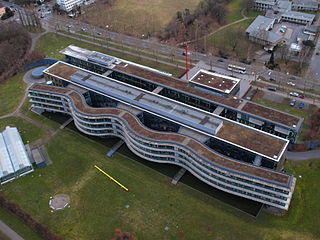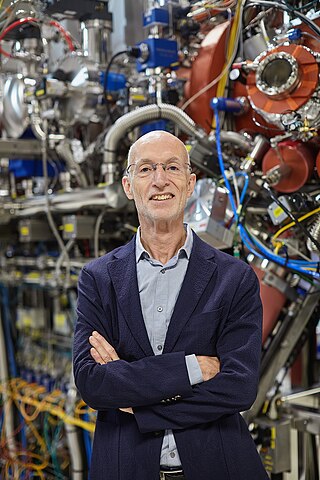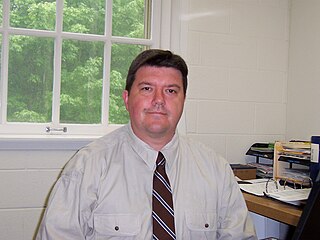Related Research Articles

The Max Planck Society for the Advancement of Science is a formally independent non-governmental and non-profit association of German research institutes. Founded in 1911 as the Kaiser Wilhelm Society, it was renamed to the Max Planck Society in 1948 in honor of its former president, theoretical physicist Max Planck. The society is funded by the federal and state governments of Germany.

The Molecular Foundry is a nanoscience user facility located at the Lawrence Berkeley National Laboratory in Berkeley, California, and is one of five Nanoscale Science Research Centers sponsored by the United States Department of Energy.

Max Planck Institute for Neurobiology of Behavior – caesar in Bonn is a non-university research institute of the Max Planck Society. It was founded on 1 January 2022. The institute had been associated with the Max Planck Society since 2006, known as the Center of Advanced European Studies and Research (caesar) and has had its focus on neurosciences since this time.

The Max Planck Institute for Biophysical Chemistry, also known as the Karl-Friedrich Bonhoeffer Institute, was a research institute of the Max Planck Society, located in Göttingen, Germany. On January 1, 2022, the institute merged with the Max Planck Institute for Experimental Medicine in Göttingen to form the Max Planck Institute for Multidisciplinary Sciences.

Stuart Stephen Papworth Parkin is an experimental physicist, Managing Director at the Max Planck Institute of Microstructure Physics in Halle and an Alexander von Humboldt Professor at the Institute of Physics of the Martin-Luther-University Halle-Wittenberg.
The Max Planck Institute for Solid State Research was founded in 1969 and is one of the 82 Max Planck Institutes of the Max Planck Society. It is located on a campus in Stuttgart, together with the Max Planck Institute for Intelligent Systems.

Stefan Walter Hell is a Romanian-German physicist and one of the directors of the Max Planck Institute for Multidisciplinary Sciences in Göttingen, and of the Max Planck Institute for Medical Research in Heidelberg, both of which are in Germany. He received the Nobel Prize in Chemistry in 2014 "for the development of super-resolved fluorescence microscopy", together with Eric Betzig and William Moerner.

The Fritz Haber Institute of the Max Planck Society (FHI) is a science research institute located at the heart of the academic district of Dahlem, in Berlin, Germany.

David J. Smith is a Regents' Professor of physics at Arizona State University. He is an Australian experimental physicist and his research is focussed on using the electron microscope to study the microstructure of different materials. He is a pioneer in high-resolution relectron microscopy technique and is very well known in his field. His interests are focused on thin films, nanostructures, novel materials and magnetism.

The Max Planck Institute for Sustainable Materials is a research institute of the Max Planck Society located in Düsseldorf. Since 1971, it has been legally independent and organized in the form of a GmbH, which was formerly supported and financed in equal parts by the Max Planck Society and the Steel Institute VDEh. The Max Planck Society has been the sole shareholder since 2020.

The Max Planck Institute for the Science of Light (MPL) performs basic research in optical metrology, optical communication, new optical materials, plasmonics and nanophotonics and optical applications in biology and medicine. It is part of the Max Planck Society and was founded on January 1, 2009 in Erlangen near Nuremberg. The institute is based on the Max Planck Research Group "Optics, Information and Photonics", which was founded in 2004 at the University of Erlangen-Nuremberg, as a precursor. The institute currently comprises four divisions.

David Carroll is a U.S. physicist, materials scientist and nanotechnologist, Fellow of the American Physical Society, and director of the Center for Nanotechnology and Molecular Materials at Wake Forest University. He has contributed to the field of nanoscience and nanotechnology through his work in nanoengineered cancer therapeutics, nanocomposite-based display and lighting technologies, high efficiency nanocomposite photovoltaics and thermo/piezo-electric generators.
Spin-polarized electron energy loss spectroscopy or SPEELS is a technique mainly used to measure the dispersion relation of the collective excitations, over the whole Brillouin zone.
Knut W. Urban is a German physicist. He has been the Director of the Institute of Microstructure Research at Forschungszentrum Jülich from 1987 to 2010.
Frank Neese is a German theoretical chemist at the Max Planck Institute for Coal Research. He is the author of more than 440 scientific articles in journals of Chemistry, Biochemistry and Physics. His work focuses on the theory of magnetic spectroscopies and their experimental and theoretical application, local pair natural orbital correlation theories, spectroscopy oriented configuration interaction, electronic and geometric structure and reactivity of transition metal complexes and metalloenzymes. He is lead author of the ORCA quantum chemistry computer program. His methods have been applied to a range of problems in coordination chemistry, homogeneous catalysis, and bioinorganic chemistry.

The State Research Center for Optics and Material Sciences (OPTIMAS) connects two areas of research for which the University of Kaiserslautern has a national and international reputation, founded upon relevant contributions to the development of laser physics, photonics and plasmonics. Researchers in Kaiserslautern have also been prominent in the development of magnetic, electronic and molecular materials, as well as thin films, nanostructures and ultracold quantum gases. In order to continue building on this research foundation, OPTIMAS has been established at TU Kaiserslautern within the framework of the research initiative of the state of Rhineland-Palatinate.

The "Centre d’Élaboration de Matériaux et d’Etudes Structurales" (CEMES) is a CNRS laboratory located in Toulouse, France.
{{Infobox scientist | name = Marina Bennati | workplaces = [[Max Planck Institute for multidisciplinary Sciences]
[University of Göttingen]]
Goethe University Frankfurt
Massachusetts Institute of Technology | alma_mater = University of Stuttgart
University of Münster | thesis_title = Zeitaufgelöste Elektronen-Spin-Resonanz an photoangeregten Zuständen spezieller Donor-Akzeptor-Systeme | thesis_url = http://www.worldcat.org/oclc/258062810 | thesis_year = 1995 }}
Johannes Heydenreich was a German physicist who researched on the applications of electron microscopy in solid state physics and materials science.
Jürgen Kirschner is a German solid state physicist and a director at the Max Planck Institute of Microstructure Physics. Kirschner is known for his research in electron spectroscopy, including instrument development and the study of magnetic materials.
References
- ↑ "Celebrating 30 years of Max Planck Institute of Microstructure Physics". www.mpi-halle.mpg.de. Retrieved 2022-12-11.
- ↑ "Theory Department". Archived from the original on 2009-05-18. Retrieved 2009-03-14.
- ↑ "MPI-Exp.Dep.1: Home". www.mpi-halle.mpg.de. Archived from the original on 2009-03-06. Retrieved 2009-03-14.
- ↑ "Research Areas". www.mpi-halle.mpg.de. Archived from the original on 2009-03-13. Retrieved 2009-03-14.
- ↑ "International Max Planck Research School for Science and Technology of Nanostructures : Welcome!". Archived from the original on 2009-03-07. Retrieved 2009-03-14.